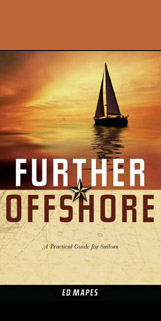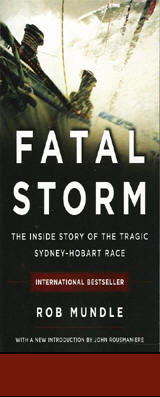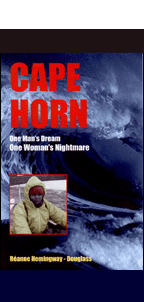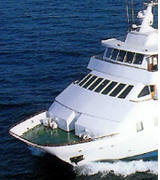|
|
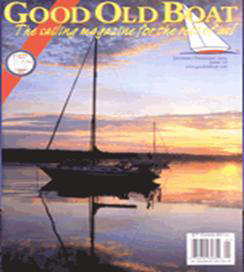 “Drag devices: Sea anchors & drogues”
by Cary Deringer “Drag devices: Sea anchors & drogues”
by Cary Deringer
appearing in the Jan/Feb 2002 issue of
Good
Old Boat.
Taking the weather for granted is easy to
do on a nice day. Sails are filled with a gentle wind, and the boat
heels slightly as it slices through rippling water shimmering beneath a
warm sun. On days like these it is hard to imagine that sailing can be a
totally different experience when conditions turn rough.
During extremely heavy weather sailors may
wish to deploy a drag device, such as a parachute sea anchor or a
drogue. To do this, of course, you need to have a drag device aboard
before you leave shore. That calls for making a major purchasing
decision in preparation for circumstances you hope you never have to
face.
Depending upon personal preference and
boat design, the choice will vary from one sailor to the next. These
issues complicate this decision: each device is a specialized piece of
gear, each produces a very distinct result when deployed, and storm
conditions vary.
Some boaters have solved the problem by
owning several types of devices. Others feel the need to choose because
of issues such as cost, storage space, and the additional weight of the
gear on an already heavily loaded cruising boat. For those who must
choose between a parachute sea anchor and/or one of the two basic types
of drogues, it is helpful to understand some of the basic principles
behind these devices.
A quick comparison
A parachute sea anchor is typically deployed off the bow. It will almost
stop the boat, allowing only a very slow drift downwind. It is a passive
device. It does not demand the continuous attention of the crew. During
heavy weather, the sea anchor allows the captain and crew to deal with
exhaustion and seasickness, to maintain adequate nourishment, to tend to
the boat, and to maintain rational decision-making abilities. To enable
a safe landfall, a sea anchor can hold a boat in a favorable position
until a heavy fog clears or daylight arrives. It can keep a boat off a
lee shore until engine repairs can be made or help arrives. It provides
a stable boat from which it is easier to dive, fish, or check your
navigation.
A drogue, on the other hand, is deployed
off the stern. There are two basic types of drogues. The low-drag,
speed-limiting drogues are sized to allow the boat to maintain three to
six or perhaps even seven knots in conditions where it might otherwise
be driven well above hull speed. The slower speed prevents a boat from
surfing down wave fronts. With the stern held down, the chance of
pitchpoling is reduced. When speed is controlled in this way, yawing is
reduced, making it easier to keep the boat from turning beam to the
waves. The low-drag speed-limiting drogue is an active device. It makes
steering easier, but it does not eliminate the need for the crew to be
in the cockpit steering the boat. Most drogues are of this type.
The medium-pull drogue is also deployed
off the stern, but it brings the boat almost to a stop. Downwind drift
will be 1 to 1 1/2 knots in storm conditions, which is not fast enough
to steer. The designer of the Jordan Series Drogue recommends that the
crew go below and strap themselves in. The medium-pull drogue is a
passive device like the parachute anchor.
Parachute sea anchors
Historically, a sea anchor was anything from a leather bucket to a
cone-shaped canvas scoop used off the bow to hold the boat in a safe
position when faced with heavy wind and waves. Later, commercial
fishermen and then sailors began using military surplus parachutes as
sea anchors for the same purpose, thereby coining the name parachute sea
anchor. These large-diameter devices have evolved over the years and
offer much more holding power than their cone-shaped cousins.
Size is an important, and somewhat controversial, issue. A parachute sea
anchor must be of an appropriate diameter to prevent the bow from
falling off the wind and turning the boat broadside to the seas. Too
small, and there may not be enough purchase power to accomplish this
task. Some advocate a “when in doubt, go larger” attitude. But an
oversized canopy can have its disadvantage, too.
Surviving storms with the aid of drogues and sea anchors
A boat forced aft against an oversized canopy that is “fixed” in the
water can present problems. In his book, Heavy Weather Tactics Using Sea
Anchors and Drogues, Earl Hinz points out, “The powerful but irregular
motion of the sea when resisted by a sea anchor can produce great
strains on the sea anchor gear. The dynamic of loading will give all of
the problems found in ground anchoring, such as overloading cleats and
Samson posts, causing severe chafe on the rode, and occasionally burying
the bow in green water.” Larger chutes tend to take up more storage
space aboard, cost more, and are often more difficult to deploy and
retrieve.
The most frequently expressed concerns regarding the use of parachute
sea anchors have to do with the deployment and retrieval process. One
danger: when deploying a parachute sea anchor the chute can catch the
wind and open up on deck—a common problem with the old military surplus
chutes. Another deployment foul-up can occur if lines, either shroud
lines or the trip line, become tangled during storage or deployment.
Depending upon the company from which you purchase a parachute sea
anchor, the deployment procedure may vary slightly. In general, a
parachute sea anchor is dropped off the bow to windward. Some sea
anchors come with deployment bags that prevent the parachute from
filling with air when being launched. In the absence of such a bag, it
is helpful if the chute is wet when it is put over the side. Once
deployed, the rod is snubbed to allow the chute to open. Then a
sufficient amount of line is payed out. Ideally, both boat and anchor
should ride in the same wave phase even though the parachute sea anchor
may be several wavelengths away.
Sea anchor retrieval
Deploying the parachute sea anchor is only half of the procedure.
Retrieving it successfully is the other half. A trip line can make the
retrieval process easier. The next choice is whether to use a full or
partial trip line. Full trip lines extend from the apex of the chute all
the way back to the boat; partial trip lines run to retrieval floats.
If a partial trip line is used, retrieval involves motoring slowly up to
the float while the main anchor rode is taken in gradually. A boathook
can be used to snag the trip line, which is then pulled in, followed by
the parachute sea anchor and the remaining rode. Maintaining tension in
the rode as you power up to the retrieval float and timing your moves
with ocean waves or swells are the keys to successfully bringing the
parachute sea anchor onboard.
If the rode is allowed to go slack before the trip line is activated,
the canopy can change positions in the water. This scenario would be
similar to having a large-diameter bucket hanging from the bow beneath
the water surface. With the bow weighted, it is unable to rise up over
oncoming waves and instead causes the bow to be pulled down. Retrieval
of the parachute sea anchor from this position is more difficult,
especially without a trip line. Smaller parachute sea anchors can be
simply brought in by hooking a shroud with a boathook and dumping the
chute by pulling on it.
Controversial matter
Another concern about using parachute sea anchors is whether they will
always hold the bow of a boat upwind. This is a controversial matter.
Left to its own devices with no drag device, a modern monohull will
normally lie ahull, meaning beam to the wind. This is caused at least in
part by the center of aerodynamic drag (force of the wind) being forward
of the center of hydrodynamic drag (force of the water acting on the
hull). This is particularly true if the boat is not carrying sail. The
sea anchor must overcome this natural tendency and pull the bow into the
wind.
In his book, Drag Device Data Base, Victor Shane has collected the
experiences of sailors using parachute anchors and other drag devices in
heavy weather. His finding strongly indicate that multihulls (using
bridles) are held head to wind, and yaw is minimal. The picture
concerning monohulls is less clear. Some boats did very well; others did
less well. There were not enough cases reported to show clear trends,
but it seems that schooners and yawls did better than sloops and
cutters, and fin-keeled boat did better than full-keeled boats. It also
seems that there was less yaw as the wind speed increased. These
“trends” are vague, however. Lin and Larry Pardey, for example, are
quite satisfied with the performance of their full-keeled cutter when
using a parachute anchor. They also use a special bridle arrangement
which is intended to hold the bow as much as 50 degrees off the wind.
California-based manufacturer Fiorentino’s sea anchor sales literature
suggest a similar arrangement.
Recommendations on rode thickness and length vary among the different
manufacturers, but nylon is the material of choice because of its
elasticity. The loads on a parachute sea anchor rode may be equal to the
displacement of the boat in storm conditions. The rode is one accessory
that can serve double-duty elsewhere, such as for use with ground
tackle. However, using it for other purposes reduces its strength due to
simple wear and tear. It may be better to have such gear specifically
assigned for use solely with the parachute sea anchor if space and
budget permit.
There are a few other issues to address when using a parachute sea
anchor system. Lashing the tiller with a semi-flexible lashing such as a
heavy shock cord, for example, reduces the chances of rudder damage when
sever waves force the boat astern. Chafe is likely to be the most
serious problem encountered when using any drag device. It deserves
advanced planning. Once the sea anchor is deployed in storm conditions,
the load on the rode will make adding chafing difficult, and the bow
will not be an easy place to work. Depending upon conditions and boat
design, a riding sail aft may be needed to reduce the amount of yaw that
might be encountered.
Drogues
While a monohull’s “natural” tendency is to lie ahull, in most cases it
is quite easy to get these boats to be fairly stable sailing dead
downwind under bare poles. Drogues take advantage of this natural
stability. There are both unitary and series drogues. A unitary drogue
is deployed as a single drag device attached at the end of a length of
rode. A series drogue utilizes smaller drag devices, such as cones, all
of which are attached along a length of rode.
Unitary drogues
Most drogues are unitary drogues, and most unitary drogues are intended
to reduce a boat’s speed to a safe and manageable level while allowing
for a fair amount of directional control by the helmsman. Keeping the
boat below hull speed can prevent surfing down large wave fronts and
punching the bow into the back of the next wave in the trough. These
drogues are referred to as speed-limiting or low-drag drogues to
contrast them with medium-drag drogues (like the Jordan Series Drogue
which is designed to virtually stop the boat). These drogues require
active participation from the crew, but allow the helmsman greater
control and ease of steering. In situations where it is desirable to
keep moving to reach shelter, or to maneuver to a more favorable part of
the weather system, these devices are preferable. However, the same low
drag that grants more steering control can also make the boat more
vulnerable to capsizing, broaching, or pitchpoling in a
“once-in-a-lifetime storm.”
In addition, with a single drag device at the end of a long rode, the
boat is more susceptible to large waves that approach from an angle. In
order for a boat to get assistance from the drogue, it must position
itself by swinging at the end of the long rode. The time it takes to do
this can be crucial, and failure can result in a wave hitting the boat
broadside.
Series Drogue
Series drogues were invented and developed by Donald Jordan. These
drogues are deployed off the stern but, like the bow-deployed parachute
sea anchor, they are intended to almost stop the boat. In this manner,
the stern of the boat faces toward the wind and waves. The advantage of
this is that the boat is much more stable pointing and sailing slowly
downwind. There is less tendency to yaw because the mast and other high
wind-drag items are downwind of the keel and rudder which are the high
water-drag items.
A properly sized series drogue will keep the boat speed down to 1 to 1 ˝
knots in storm conditions, so it does not require the crew to steer. In
this attitude if the boat is struck by a large breaking wave, which is
the most dangerous threat to a boat in heavy weather, the boat will be
briefly accelerated up to wave speed, and then as the wave passes it
will be dragged back by the series drogue. Unlike the sea anchor, the
series drogue is intended to control the loads on the rode, fittings,
and attachment points by allowing the breaking wave to accelerate the
boat. It is not intended to have enough drag to resist this large and
rapidly developed force. It does have enough drag to quickly bring the
boat speed back down after the breaking wave passes. It will prevent the
boat from being thrown into the trough. Donald Jordan asserts that a
breaking wave will not damage a boat by striking it but can damage it by
throwing it into the trough. The Jordan Series Drogue typically is made
up of more than 100 small fabric cones. These smaller drag devices are
located all along the length of the rode. Therefore, if half the cones
are inactive within the slack portion of a wave, the other half are
still capable of maintaining a hold on the boat. Also, if a large wave
is approaching from an angle off the stern, the drag devices closer to
the boat, where the rode elasticity is low, will create a load much
faster than if a unitary drogue were being towed at the end of a long
rode. The drogue is weighted by chain at the end, which makes it
function below the wave action and keeps a constant tension on the rode.
High stress
Because of the way the Jordan Series Drogue works, the stern will be
struck by breaking waves. This is a controversial aspect of the device.
Critics assert that the transom, cabin trunk, and drop boards must be
capable of taking the full impact of breaking waves and that the impact
will be severe. Donald Jordan contends that experience with his drogues
has proven that this is not a problem. In any case, the cockpit should
be able to drain water quickly, and all drogue attachments should be
well backed up to help spread the loads imposed upon the gear. In
addition, it is not intended that the crew be in the cockpit when the
drogue is in use. The speed will be kept too low to allow the boat to be
steered, and the crew should go below.
Deployment of any drogue generally takes place over the stern. The whole
assembly should be carefully checked to ensure knots are properly tied,
shackles are safety wired, the bitter end is attached to the boat, and
the system is free of tangles with itself as well as parts of the boat
and crew.
When the boat is in the trough of a wave, its speed is at its minimum.
This is the time to deploy the drogue. In the case of unitary drogues, a
portion of the rode nearest the boat is deployed first. As the boat
moves forward, the water will pull the rode along in a bight. More of
the rode is paid out until the drogue itself is reached. The device,
previously laid out and checked for tangles, is then released. The
series drogue has a length of anchor chain at the end to keep it below
the surface. This is dropped into the water, and the drag from the chain
is allowed to pull the rest of the drogue overboard. The series drogue
is intended to be permanently attached to a bridle on the transom and
ready for deployment at any time.
Unitary drogues can also use an adjustable bridle setup. The main rode
is led off to one side of the transom and secured to a strong cleat or
reinforced attachment point, preferably forward of the rudder post to
improve steering. A snatch block with a pendant line tied to it is then
snatched onto the main rode. The pendant line is run off the other side
and led to a winch for adjustment. This system allows the crew to
position the boat’s stern to oncoming waves, exposing, for example, only
the quarter portion of a flat transom to the full impact of a breaking
wave.
Retrieval of the drogue must be done carefully due to the forcefull drag
produced by the device in the water. On a sailboat, winches can be used
to haul in the main rode once the pendant line is released. When
operating under power, the rode can be taken to the bow and brought in
as the boat motors back to the drogue.
Summary
Once you have made a decision to purchase a parachute sea anchor or
drogue, take the time to research all available options.
“Silver-bullet storm tactics” are hard to come by because of the variety
found in weather conditions, boat designs, personal preferences, and
crew capabilities. There are other tactics to employ in heavy weather,
such as running under bare poles and heaving-to. Using a drag device
requires prior planning since the equipment must be aboard. If it is to
be effective it must be ready for deployment, and you must be
comfortable using it. If you equip your boat with drag devices, practice
deploying them in moderate conditions. Get familiar with the components.
Make sure all crew members know the procedure and their
responsibilities.

Click
here
to learn more about
Good
Old Boat Magazine.
|
|

 “Drag devices: Sea anchors & drogues”
by Cary Deringer
“Drag devices: Sea anchors & drogues”
by Cary Deringer




